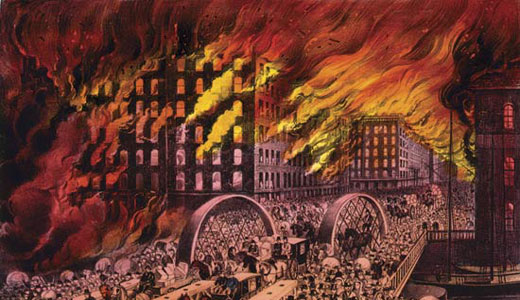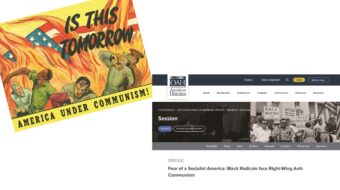
On Oct. 8, 1871, the Great Chicago Fire broke out. It burned for three days, killing between 200 and 300 people, destroying 17,450 buildings, leaving 100,000 homeless and causing damages worth an estimated $200 million in 1871 dollars – more than $3 billion in today’s dollars. Among the small businesses destroyed was the dressmaking shop of the young Mary Jones, who was spurred to become a labor organizer known to millions as “Mother” Jones.
Four square miles of the city, including its business district, were left in ruins. Thirty of Chicago’s 185 firefighters were injured battling the blaze.
One legend, which has been called an anti-Irish slur, said the fire was ignited by a cow kicking over a lantern in the Chicago barn of Patrick and Catherine O’Leary. Later research points to other causes, including a careless smoker. In 1997, the Chicago City Council exonerated Mrs. O’Leary and her cow.
In fact, dry weather and mostly wooden buildings, streets, and sidewalks made Chicago, like many other American cities, very vulnerable to fire. Chicago averaged two fires per day in 1870. Just the week before the Great Fire of 1871, there were 20 fires throughout Chicago.
Despite the fire’s devastation, much of Chicago’s physical infrastructure, including its water, sewage, and transportation systems, remained intact. Reconstruction efforts spurred great economic development and population growth, with architects making the city home to the world’s first skyscrapers.
At the beginning of the 1880s, Great Lakes shipping magnate Eber Ward’s Illinois Steel Company opened a mill at the mouth of the Calumet River on Chicago’s South Side – the famous South Works. Several other mills became major rail producers. The Union Rolling Mill Company, built in 1863 on the South Branch of the Chicago River, employed about 600 workers by 1873. The Joliet Iron and Steel Company employed about 1,500 men soon after it opened in 1871. By the 1880s, these three companies accounted for nearly 30 percent of the total U.S. output of steel rails. In 1880 the Pullman Palace Car Company brought its plant and model city to Chicago’s South Side, becoming a center for railroad sleeping car production.
At the time of the Great Fire, Chicago’s population was approximately 324,000. Within nine years, it had jumped to 500,000. By 1893, the city was a major economic and transportation hub with an estimated population of 1.5 million. That same year, Chicago was chosen to host the World’s Columbian Exposition, a major tourist attraction visited by 27.5 million people, approximately half the U.S. population at the time.
Photo: Great Chicago Fire of 1871. Library of Congress












Comments